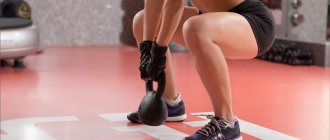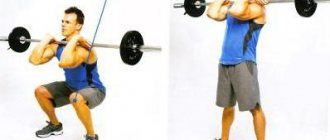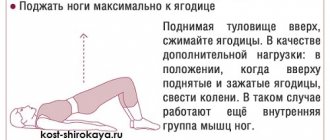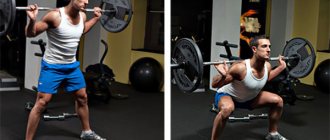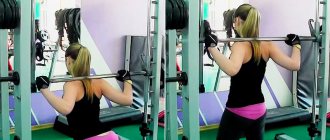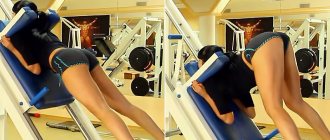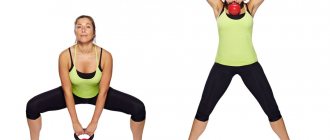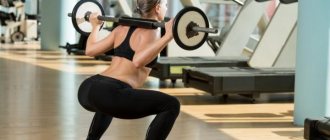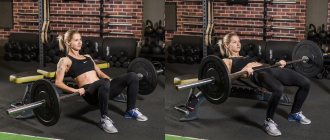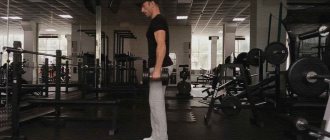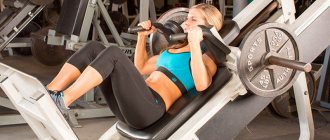Squats are one of the most effective exercises for giving volume and beautiful shape to the buttocks. You will learn how to squat correctly to pump up your gluteal muscles, and what additional exercises will help you gain beautiful shape. Knowing the structure, functions of muscles, and technique of performing exercises, you can easily achieve the desired elasticity and volume of the butt.
- Anatomical structure
- What are the benefits of squats? Is it possible to pump up your buttocks with squats?
- Classic with own weight
- Why don't my buttocks hurt after squats?
Anatomical structure
The gluteal muscles belong to the back surface and include: gluteus maximus, gluteus medius and minimus. The gluteus minimus is located under the gluteus maximus, which occupies most of the buttocks. The function of the gluteus maximus muscles is to straighten the torso, as well as move the legs back and to the side. The functions of small and medium ones are only to move the legs to the side. The gluteus maximus is, to a greater extent, included in the extension of the torso during exercises such as:
- squats with a barbell or dumbbells;
- lunges;
- Romanian deadlift;
- deadlift;
- bending over with a barbell on your shoulders.
The gluteus medius and minimus muscles work under the following loads:
- leg raises while sitting in a machine;
- standing leg abduction with a machine lever;
- swing your leg to the side from the lower block;
- swing your leg while lying on your side.
The structure of the muscles of the buttocks
Let's get acquainted with the anatomy of the buttocks. So, here is their structure:
- the most important is the large muscle. It is they that occupy most of the buttocks and show the greatest activity during body extension;
- Below this muscle is the middle one. She gets especially tense when running, walking, or climbing stairs;
- The small muscle is located above the large muscle. It works together with the middle one.
To better work the gluteal muscles, squats should be performed as deeply as possible. To avoid damaging your knee joints, do not make sudden movements.
What are the benefits of squats?
This exercise uses a large number of muscle groups, improving physical fitness and strengthening the cardiovascular system. By doing squats, you can not only achieve beautiful shapes of the gluteal muscle, but also strengthen your back and abdominal muscles. Exercise provides pressure in the chest, which improves the respiratory system, saturating the body with more oxygen.
Is it possible to pump up your buttocks with squats?
Considering that the buttocks are involved in straightening the torso, squats are one of the best methods to pump up your butt well. And the lower the squats, the better the gluteal muscles work and the more effective the exercise is for elastic buttocks.
Important to remember! In order to make your buttocks strong, you need to lift weights. To do this, you need to perform an exercise to grow muscle mass, from 8 to 12 repetitions in one approach. Between approaches you need a rest of 1 - 2 minutes. The weight of the load should be heavy enough so that you do not have enough strength to perform more than 12 repetitions, this is the effectiveness of the exercise. But it’s better to start mastering the technique with light weights, gradually adding load each workout.
Technique for performing squats with a barbell
- Place the bar in a special power frame at shoulder level. Approach the bar with your back, placing the bar on the upper part of the trapezius, in no case do not place the weight on the cervical vertebrae;
- After removing the barbell from the racks, take a couple of steps back, placing your feet pelvis-width apart. Socks are parallel to each other, or slightly apart. The chin is slightly raised so that you can look up;
- Inhale: slowly squat, lowering your hips horizontally. The knees form an angle of 90 degrees, and the knees should not go beyond the toes, as this will injure the knee joint. The gaze is directed upward, the back is straight, the shoulder blades are brought together. Elbows point slightly back.
Remember! The lower back is not rounded and the body does not lean forward too much. We stretch our tailbone back - this is mandatory when performing the technique for the growth of the gluteal muscles, this increases the stretching of the muscle.
- Exhale: using more force from the gluteal muscles, we perform a faster rise, straightening the knees and straightening the torso. When returning to the starting position, it is advisable not to straighten your knees completely in order to relieve the load on your knees.
Deep plie squats for men and women
We looked at mid-leg squats, which primarily work the glutes, hamstrings, and quadriceps. In order to focus on the inner thigh, which is rarely used in everyday life and in any exercises, even during squats, you can try deep plie squats.
To engage the muscles of the inner thigh, squats with wide legs are perfect.
This exercise makes it possible to work out problem areas for girls and women. For men, this is a way to make the hip more symmetrical.
Technique:
Plie squats can be performed without weights, with one or two dumbbells, with a barbell on your shoulders or on your chest, you can also take a kettlebell or a barbell plate. You should start without a projectile and gradually move on to more complex options.
- Place your feet wider than your shoulders and point your toes out to the sides. How wide to place your legs should be determined by your personal feelings and height (if your legs are long, you can place them wider).
- The back is straight, there is a natural arch in the lower back, the shoulder blades are brought together, the shoulders are straightened.
- We don’t lower our gaze, we look straight ahead.
- It is better to stretch your arms forward for balancing.
- As you inhale, we slowly sit down, feeling the stretch in the inner thigh. Be sure to keep your knees pointing in the same directions as your toes, rather than curling inward.
- The body can be moved forward a little.
- We squat just below parallel with the floor. You won’t be able to squat low as with a mid-leg position, but the pelvis should be below the hip line.
- As you exhale, we return to the starting position. We repeat the exercise the required number of times.
We do plie squats without weight 15–20 times. With weights - 6–8 times. 3-4 working approaches will be enough.
Technique for performing deep plie squats.
Types of squats for the buttocks at home, to quickly increase your butt
Below you will find tips and recommendations on how to squat correctly to pump up a girl’s buttocks without the help of a trainer, even at home without exercise equipment. We have described the technique for performing each
Classic with own weight
The exercise primarily works the gluteus maximus, quadriceps femoris, and adductor muscles. When working with your own weight, the lumbar extensor and core are less loaded. Squats are the most important and difficult exercise in physical culture, so the body must be well prepared for it. You can do bodyweight squats right away by practicing proper technique, even if you're a beginner. But for proper preparation, you need to tone all the muscles, then after a while, you can move on to squats with a barbell. Therefore, bodyweight squats are good for understanding technique and toning muscles, but you won’t be able to build curves this way.
Deep
Deep squats, where the pelvis drops below parallel to the floor, forming an acute angle at the knees, best load the gluteus maximus and gluteus medius muscles. Also, during the load, the quadriceps, lower back, abs, and adductor muscles of the thigh are involved. It is a deep squat that can put more load on the buttocks, since they are the first to engage when the torso straightens. The range of movement also increases, which provides greater tension and effort in the muscles. To grow the buttocks, it is recommended to squat deeper than with the classic version. The exercise is performed provided that the ankles are flexible enough, otherwise a deep squat will not be possible due to the peculiarities of physiology.
With a narrow stance
This placement of the feet is set shoulder width apart, not too close, this will ensure a stable body position. The following muscles are involved: quadriceps femoris, gluteus maximus and medius, adductors, lower back and abdominal muscles. In this option, the gluteal muscles are optimally worked out. But it is necessary to take into account morphological features: length of the thigh, flexibility of the ankles, ligaments, length of the body. With individual characteristics, it can be difficult to implement this option. Therefore, you can place your feet a little wider, parallel, or slightly turn your toes out. Then the position will be more stable and the muscles will be properly loaded. The main thing is to squat until your thighs are horizontal.
Sumo
Sumo or wide squats include the gluteus maximus and medius, quadriceps femoris, adductor major and longus, and gracilis muscles. The wide position of the feet in this version provides a load on the adductor muscles of the thigh, working these groups more strongly than classic squats. This exercise should be part of a set of exercises, but should not be the only one and often repeated, as it noticeably increases the shape of the inner thigh.
Curtsy
The exercise is also known as cross lunges. The main part of the load is taken on by the gluteus maximus and medius, and the quadriceps muscles of the thigh. Additionally: hamstrings, abs, back, semitendinosus and semimembranosus muscles. Lunges are a great addition to squats in a leg program, and there are many variations of this exercise. An important condition for carrying out such a load is flexible joints. The exercise stretches the gluteal muscle well.
With dumbbells or kettlebell
The technique of squats with dumbbells remains the same as in classic squats with a barbell; the same muscles work. But the advantage of the exercise is that it does not subject the spine to compression. Vertebral injuries, displacements, osteochondrosis, intervertebral hernias are a contraindication to squats with weights on the shoulders. Therefore, this type of load will be a good alternative to a barbell.
Plie
An exercise with widely spread feet, similar to the ballet “Plie” technique, trains the gluteus maximus and gluteus medius, a group of adductor muscles of the thigh. The auxiliary muscles are: quadriceps femoris, lower leg, abdominal muscles. When performing this exercise, sufficient flexibility of the hip joint is necessary. The good thing about this exercise is that it doesn’t overload the quadriceps. But to grow the buttocks, you need an optimal load weight; you need to ensure concentrated movement through the gluteal muscles, without overloading the adductor hips.
Deep on one leg
The advantage of the pistol exercise is that it develops muscles well by working with your own weight. The exercise does not require additional equipment. But it is not so easy to learn, and a sufficiently trained person can perform it. The exercise works the quadriceps and gluteus maximus muscles. Only for the knee joints the exercise is quite traumatic. The acute angle of the knee receives a lot of stress and this is a contraindication for any problems and pain in the knees.
With a barbell
Working with free weights, especially squats with proper technique, is the best assistant for elasticity and growth of the gluteal muscles. An exercise in which the muscles perform a stabilizing function, providing balance, trains beautiful forms faster and better. Contraindications to training with a barbell: injuries and diseases of the spine.
In the Smith machine for beautiful buttocks
The Smith Squat Machine is a great alternative to barbell squats, but it won't last forever. To adapt the muscles to the load, while the muscle corset has not yet formed and the technique with the barbell is still complex, it is quite advisable to perform squats in a Smith machine. Support on the bar, a stable position of the body and knees will ensure the correct load on the butt and quadriceps of the thigh. You can perform the squat technique with different foot positions.
What muscles work during deep squats?
Like any type of squats, this option is a basic exercise, during which almost all the muscles of the body are involved in the work.
With a shallow squat, the emphasis shifts to the front surface of the thigh, but deep squats work both the hamstrings and gluteal muscles very well - they receive a relatively greater load than with classic squats.
When doing deep squats, the same muscles are involved in the work as in the classic version, but the load on the back of the thigh will be greater.
The lower back is also more actively involved in the work. A large number of joints work, especially the legs and back.
A set of squats for buttocks for 30 days
Attention : Each approach increases the weight of the load, decreases the number of repetitions.
Table of exercises performed by week for a month.
| Approach 1 | Approach 2 | Approach 3 | Approach 4 | |
| 1 Week | 20 | 15 | 12 | 12 |
| 2 week | 15 | 12 | 10 | 10 |
| 3 week | 12 | 10 | 10 | 8 |
| 4 week | 12 | 10 | 8 | 8 – 6 |
What exercises need to be added to maximally work the gluteal muscles?
In addition to basic exercises for buttock growth, the program must include auxiliary exercises that will ensure comprehensive muscle development. You can’t do without exercises such as:
- deadlift on straight or bent legs;
- bending over with a barbell on your shoulders, standing or sitting;
- swing your leg backwards in the simulator;
- gluteal bridge;
- swing your leg up, resting on your forearm;
- hyperextension;
- leg raises in the simulator.
Why don't my buttocks hurt after squats?
During physical activity, the muscles experience tension, which causes micro-tearing of the muscle fibers. If the muscles are not prepared, they usually hurt the next day. It's not a matter of lactate, lactic acid, which gets into the fiber gap and causes pain in the form of sore throat. The point is the fiber injury itself. The lactate stops after 2 - 4 hours, and the muscles hurt for several days. It's a matter of trauma. Pain caused by a rupture is not an indicator of a good and correct load. And the absence of pain is not an indicator of ineffective exercise. A prepared body that exercises regularly begins to experience less discomfort such as sore throat. This means that the body gets used to the load, and you can gradually add weight, but without fanaticism.
What should you do to avoid injury?
The first thing a workout begins with is a warm-up; warming up the muscles and ligaments will reduce the risk of injuries in the form of sprains and ruptures. Also, the technique of execution is important, this will save you from excessive stress on the joints and spine.
What weight to start with and how to increase it correctly?
It is better to perform squats with your own weight, having mastered the correct squatting technique, preferably under the supervision of a trainer, you can gradually add load. Then you can take the empty bar on your shoulders; if the body does not fall forward and the knees remain motionless, feel free to add weight. But provided that you lift with this weight. It is advisable to add no more than 5 kg, and then not every workout. If you easily completed the exercise for 12 repetitions, feel free to add load, even if you can complete 10 repetitions.
How long does it take to build beautiful buttocks with squats?
With constant load and proper rest, muscles grow depending on the constitution of the body. The result will not appear immediately; it requires constant and hard work. Everything will be individual for everyone, you can see the result in 3 to 6 months. But personal preferences also play a role; some need to gain 3 cm in volume, while others need as much as 10 cm. Accordingly, it will take more time.
How to do squats correctly?
In order for the exercises to be effective, beneficial and leave behind the so-called “muscle joy” effect (pleasant relaxation and peace after exercise), you need to follow a few simple rules.
In the ranking of the TOP 10 exercises for the buttocks, squats take first place.
- Do not lower your buttocks below your knees while squatting. This puts excessive stress on your knee joints. Deep squats can only be done under the supervision of a trainer.
- Do not hold your breath while doing the exercise. Muscle tension should be as you exhale, and relaxation as you inhale. Keep your breathing under control at all times until you do it automatically!
- smoothly and without jerking . Most injuries, such as sprains, are caused by sudden movements.
- Don’t chase results , don’t “rush into battle” right away, increase the load gradually, day after day.
- Control the execution of the exercises - the bend should be carried out in the hip joint area, and only then in the knee area.
Be sure to check out our 30-day squat program for girls
. Important! The number of squats to perform is a very individual matter for each person. To get started, consult with an instructor, and, if possible, practice under his guidance in the first stages. Often success depends not on how many approaches you do, but on whether you perform the exercises correctly. At the initial stage, do a couple of exercises in several approaches, gradually increasing the load.
